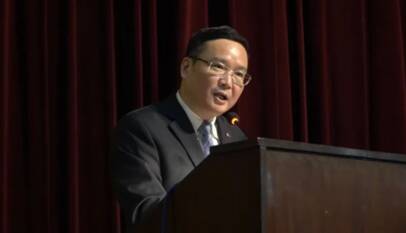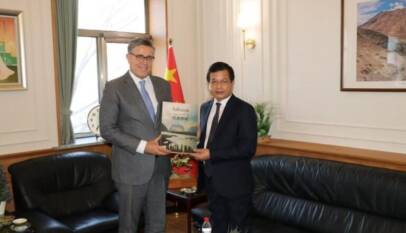CPEC early harvest projects have created over 85,000 direct jobs for locals: Pakistan Economic Survey (PES)
CPEC has contributed to the socio-economic development of Pakistan. The Pakistan Economic Survey (PES) 2019-20 noted the early harvest projects of CPEC have created over 85,000 direct jobs for locals. It noted the Special Economic Zones (SEZs) under CPEC would stimulate more employment opportunities. Development of industrial units and technological cooperation would be prioritized in the second phase of CPEC.
The PES also underlined the significance of the Gwadar port. It said the Gwadar port will be a world-class maritime hub. It will promote regional connectivity and accelerate the economic growth of Pakistan. The PES further hailed the role of the National Highway Authority (NHA) in the execution of CPEC linked road projects and mentioned CPEC western route is at different stages of implementation.
The PES reported significant progress of CPEC linked projects. It said the CPEC linked hydropower and coal-based projects were at advance stages of development and lined up to be completed during 2020-22.
ISLAMABAD: Some 18.53 million people will be unemployed in Pakistan in case of a complete shutdown (lockdown) forced by COVID-19, says the Pakistan Economic Survey (PES) releasednon Thursday.
Quoting the Pakistan Institute of Development Economics (PIDE), it said that in case of limited restrictions,about 1.4 million jobs will be lost, and under moderate restrictions employment loss could reach to 12.3 million. The PES said according to Labour Force Survey 2017-18, unemployment rate is 5.8pc while the total labour force was 65.5 million. That survey said that the highest unemployment (11.56 percent) was prevalent among the age 20-24, indicating youth unemployment.
The PIDE estimates state that the COVID-19 pandemic can have adverse impact on employment generation during the last quarter of 2019-20. The PES said Pakistan’s population density stands at 265 per kilometer while population growth rate is 2.4 percent. According to the National Institute for Population Studies, population projected for 2019 is 211.17 million. Pakistan is the fifth most populated country in the world. Presently, its population composition is skewed towards working age population. Some 61.4 percent of population is falling in the age group 15-64 while 12.1 percent of population is between the ages of 0-4 years and 22.1 percent is between 5-14 years.
The PES said if this demographic dividend is harnessed and equipped with desired skills to meet domestic and international market requirements, the youth bulge would yield increased industrial productivity and higher foreign remittances.
It said that the government is focusing on various employment generation programmes for youth. Employment is considered as key mechanism through which the benefits of the growth can be trickled down to the vulnerable segments of the society. A large number of young labour force is adding every year.
The PES said Pakistan‘s youth bulge has tremendous energy and talent and the government is making sincere efforts to provide them ample opportunities to harness their potential. Accordingly, Kamyab Jawan Programme and Hunermand Jawan Programme (Skills for All) launched by the government is helping the youth to enhance their skills which will, thus, play a pivotal role in the socio-economic reconstruction of the society.
Meanwhile, the PES said the early harvest projects under the China-Pak Economic Corridor (CPEC) have created more than 85,000 direct jobs for Pakistanis.
It said that nine Special Economic Zones (SEZs) will be established under CPEC portfolio, which will create tremendous job opportunities and technological transformation. Priority will also be given to align technical institutions and training with CPEC related trades and demand of SEZs.
The construction of Free Zone Phase-I has been completed with all infrastructures, including power, water, road, telecommunication, waste treatment, drainage systems are now in operation. More than 30 enterprises from various sectors, such as banks, insurance, financial leasing, hotels, warehouses, fishery products processing, edible oil processing, pipe, furniture manufacturing, electric vehicle assembly, trade and logistics, have already been registered in Gwadar Port Free Zone.
Three companies have completed the construction. The work on the main Free Zone on 2,220 acres of land will be started soon for which China Port Holding Company (COPHC) has completed the master planning and feasibility work.
Since 2013-14, the Gwadar Port Authority (GPA) has been part of all planning and appraisal processes of the CPEC programme. For the early harvest/prioritised phase of the CPEC, following projects related to Gwadar Port and the Port City of Gwadar have been agreed, which are in different stages of project implementation and approval.
The works on the construction of East Bay Expressway with the help of China is in full swing. Eastbay Expressway will be completed during the next financial year, which will connect Gwadar Port with hinterland through M-8 and Makran Coastal Highway.
The PES said that Gwadar Port is about 630km away from Karachi and 120 km from the Iranian border. It is in the process of becoming the Gateway Port for Pakistan and the region and a world-class maritime hub. Gwadar Port, the first deep seaport in Pakistan, is a complement to Karachi Port and Port Qasim in order to stimulate the economic growth of Pakistan in general and Balochistan in particular by better utilizing the available resources of the country.
Gwadar Port is also providing an outlet for land-locked energy-rich Central Asian States, Western China and Afghanistan through transit trade and offering transshipment facilities. In doing so, the development of both Gwadar City and Gwadar Port will make important contributions to the socio-economic development of the Gwadar district and the province of Balochistan while also contributing considerably to the national economy.
June 12, 2020: The survey reported significant progress in the China-Pakistan Economic Corridor programme. It said the CPEC portfolio comprised three hydropower projects of 2,714MW and nine coal-based projects of 8,220MW. Of this, four coal projects of 4,620MW have been commissioned while another three coal projects of 1,980MW and two hydropower projects of 1,590MW were at advance stages of development and lined up to be completed during 2020-22.
The National Highway Authority (NHA) has been playing a vital role in improving the productivity and competitiveness of businesses, and the quality of travel with an emphasis on safety, apart from creating job opportunities, said Economic Survey 2019-2020 release here on Thursday.
Pakistan is virtually bisected into two halves by River Indus and the Eastern segment is historically well developed. For better East-West connectivity, numerous bridges have been constructed across river Indus, Jhelum, Chenab, Ravi, and Sutlej. Currently, there are three North-South corridors N-5 (Grand Trunk Road,N-55 (Indus Highway) and Motorway M-1 (Peshawar-Islamabad), M-2 (Islamabad-Lahore), M-4 (Panda Bhatia-Faisalabad-Gogra-Shorkot-Khanewal-Multan), M5 (Multan-Sukkur), and M-9 ( Karachi Hyderabad Motorway) whereby M6( Sukkur-Hyderabad Motorway) is being planned on Build-Operate-Transfer mode) with only N55 on the western side of River Indus. A newly planned Western corridor of CPEC is being executed, which is at different stages of implementation.
The present NHA network comprises of 39 national highways, motorways, expressways and strategic roads. The existing portfolio of NHA consists of 40 on-going projects with an allocation of Rs 117,514.836 million in PSDP 2019-20 out of which Rs 57,371.916 million is the Foreign Exchange Component (FEC) and Rs 60,142.919 million is the local component.
To ensure smooth and efficient movement of goods and passengers while ensuring safety, NHA is planning and executing Khunjrab to Gwadar connectivity under the China Pakistan Economic Corridor (CPEC). The CPEC projects include Havelian-Thakot (N-35), Multan-Sukkur already completed and Operational, 3 Hakla-D.I. Khan Motorway, under construction, Yarik- Zhob portion of N-50 , PC-I approved by ECNEC, Zhob- Quetta portion of N-50 under tendering , Hoshab-Awaran section 400 km at design stage.
The NHA has already constructed green field segments of Motorway network viz M-1 (Peshawar-Islamabad), M-2 (Islamabad-Lahore), M-3 (Lahore-Abdul-Hakim), M-4 (Pindi Bhattian-Faisalabad-Gojra-Shorkot-Khanewal-Multan), M5 (Multan-Sukkur), E35 (Hassan Abdal-Havelian-Mansehra-Thakot) and M11 (Lahore-Sialkot) boosting economic activities. NHA is now constructing Hakla-Dera Ismail Khan and plans to execute M-8 (HoshabAwaran-Khuzdar). Public-Private Partnership Authority has approved construction of M6 (Sukkur-Hyderabad) on BoT basis.
Chinese envoy Zhao Shiren urges students to uphold integrity and strengthen China-Pakistan ties
LAHORE:The Consul Generals from several countries and other distinguished guests attended …









